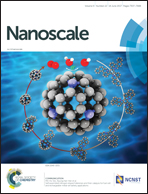Phase evolution of lithium intercalation dynamics in 2H-MoS2†
Abstract
Due to the easy intralayer gliding and weak interlayer van der Waals interaction in transition metal dichalcogenides (TMDs), ion (particularly Li+) intercalation has been used to modify and tune their atomic structures to obtain the desired optical, electronic and chemical properties for future optoelectronics and energy storage applications. A good understanding of the transformative structures during intercalation is critical. In this paper, we investigate the structural transformation dynamics of 2H-MoS2 using electrochemical Li+ intercalation for 2H-MoS2. The introduction of Li+ changes the local symmetry of the MoS2 in favor of the dT phase, clearly indicated by the appearance of Raman peaks of the dT phase. Further Li+ insertion causes the samples to become single-layer-like, characterized by the disappearance of the 32 cm−1 Raman peak. We also observe for the first time that the photoluminescence (PL) emission gradually redshifts with decreasing intensity, followed by eventual vanishing of the PL peak in the dT-MoS2 phase. By the nudged elastic band (NEB) calculations, we propose the 2H–1T–dT phase transition mechanism of MoS2 for Li+ intercalated samples. Our claims are supported by high resolution-transmission electron microscopy (HR-TEM). Our study deepens the understanding of the phase transition dynamics upon lithium intercalation, which is of great value to possible optoelectronic devices based on the phase engineering of TMDs. The new Li-stabilized dT-MoS2 phase does not possess inversion symmetry and may present a feasible way to achieve Weyl state tuning in a single material via phase engineering.



 Please wait while we load your content...
Please wait while we load your content...